Install extensions
Azure DevOps Services | Azure DevOps Server 2022 - Azure DevOps Server 2019
Install, assign, disable, and uninstall extensions, which add new features and capabilities for Azure DevOps.
For more information about extensions, see the developing and publishing overviews.
Prerequisites
- Permissions: Member of the Project Collection Administrators group. Organization owners are automatically members of this group. If you don't have permissions, you can request extensions instead or look up a project collection administrator.
- Extension sharing: Private extensions shared with your organization.
- Permissions: Member of the Project Collection Administrators group or Edit collection-level information permissions. Organization owners are automatically members of this group. If you don't have permissions, you can request extensions instead or look up a project collection administrator.
- Extension sharing: Private extensions shared with your organization.
Note
To use an existing Azure subscription for billing, have at least co-administrator permissions for that subscription. If you don't have permissions, an Azure Account Administrator or Service Administrator can add you as co-administrator to the Azure subscription in the Azure portal.
Your project collection reuses your Azure subscription for future Marketplace purchases. Where can I find more info about Azure billing?
Install an extension
Install an extension to your organization by doing the following steps.
Sign in to your organization (
https://dev.azure.com/{yourorganization}).Select the shopping bag icon, and then select Browse Marketplace.

Find the extension that you want to install and select Get it free.
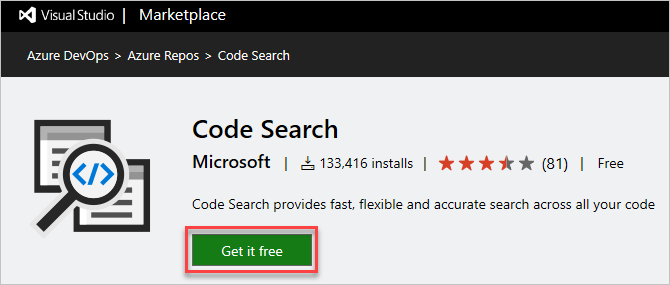
Select your organization from the dropdown menu, and then select Install to install the extension.
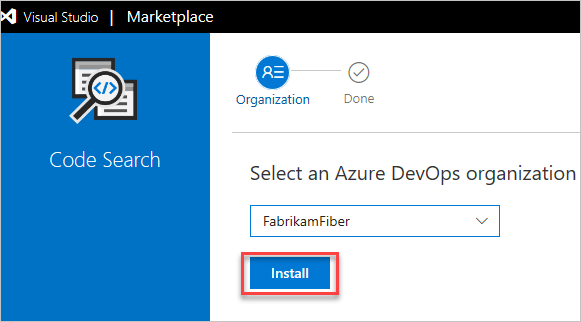
Your extension is now installed! You can now go to your organization to use your extension. Also, tell your team about this extension, so they can start using its capabilities.
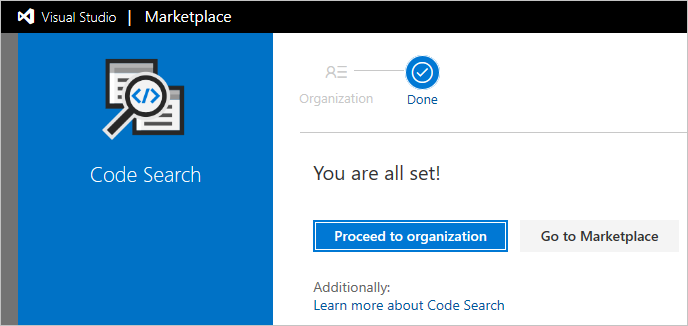
Go to Marketplace.visualstudio.com.
Sign in using your Azure DevOps credentials.
Find the extension that you want to install. Use the search box to filter the list of extensions.
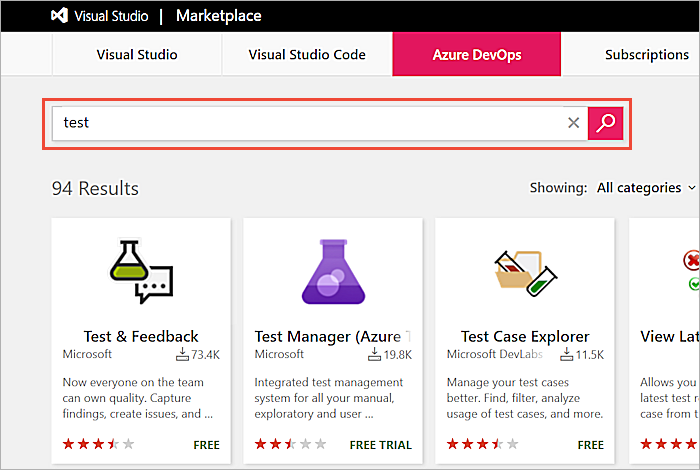
Select the extension and select Get or Get it free. Or, for some non-Microsoft extensions, select Get Started to show pricing information and extension-specific installation instructions.

If you don't have permission to install the extension, you can request an administrator to install it for you. Your request gets stored in Azure DevOps Server and is ready for attention from an administrator.
Select Download to download the vsix file.
Upload the vsix to your on premises local Marketplace. Open your Azure DevOps Server home page (
https://{server}:DefaultCollection).Go to Collection settings > Browse local extensions.

Select Manage extensions and then Upload the vsix file.
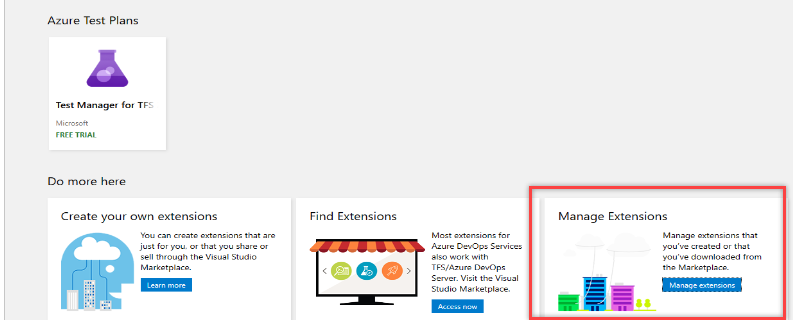
Install the extension in your project collection on the Manage extensions page. Select the project collection where you want to install the extension and choose Install.
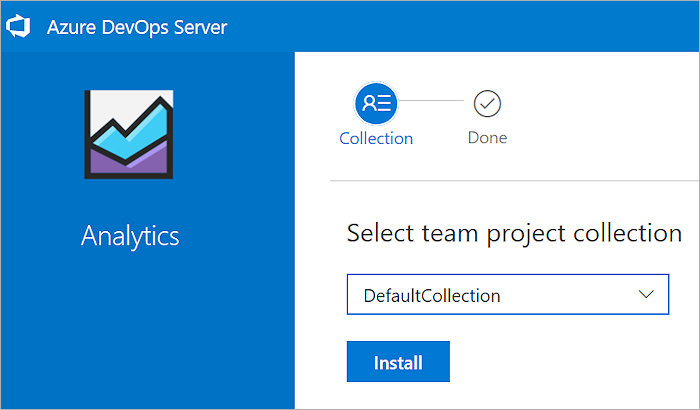
- After installation is complete, go to the project collection or return to the Marketplace to find other extensions.
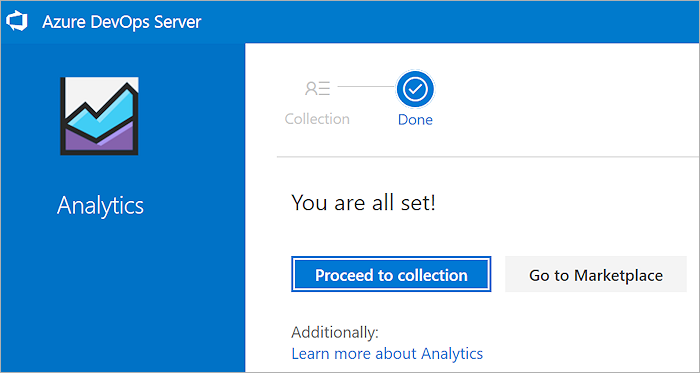
Uninstall or disable an extension
Sign in to your organization (
https://dev.azure.com/{yourorganization}).Select
 Organization settings.
Organization settings.
Select Extensions, and then select the extension that you want to uninstall or disable.

Select Uninstall or select the ellipses (...), and then select Disable.

To uninstall extensions in a collection, perform the following steps.
Go to the local gallery management portal (
http://{server}:8080/tfs/_gallery/manage).For the wanted extension, select the ellipses (...), and then select Remove.
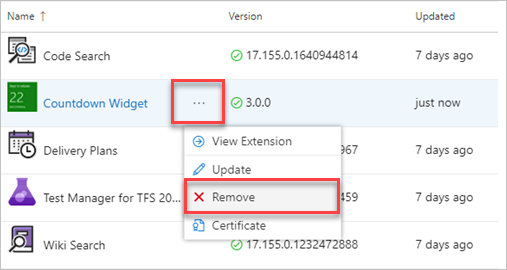
Enable or list extensions through the command line
Enable an extension with the az devops extension enable command. To get started, see Get started with Azure DevOps CLI.
az devops extension enable --extension-name
--publisher-name
[--org]
Parameters - enable extension
- extension-name: The name of the extension to enable.
- publisher-name: The name of the extension publisher.
- org: Azure DevOps organization URL. Configure the default organization with
az devops configure -d organization=ORG_URL. Required if not configured as default or picked up usinggit config. Example:--org https://dev.azure.com/MyOrganizationName/.
Example - enable extension
The following command enables the Timetracker extension and shows the result in table format.
az devops extension enable --extension-name Timetracker --publisher-name 7pace --output table
Publisher Id Extension Id Name Version Last Updated States
-------------- -------------- ----------- ----------- --------------- --------
7pace Timetracker Timetracker 5.0.1.34507 2019-11-13 none
List extensions
You can list the extensions that are installed in your organization with the az devops extension list command. To get started, see Get started with Azure DevOps CLI.
az devops extension list [--include-built-in {false, true}]
[--include-disabled {false, true}]
[--org]
Optional parameters - list extensions
- include-built-in: Include the built-in extensions. Accepted values are true (default) and false.
- include-disabled: Include the disabled extensions. Accepted values are true (default) and false.
- org: Azure DevOps organization URL. You can configure the default organization using
az devops configure -d organization=ORG_URL. Required if not configured as default or picked up usinggit config. Example:--org https://dev.azure.com/MyOrganizationName/.
Example - list extensions
The following command lists extensions in your organization. It excludes the disabled and built-in extensions, and shows the results in table format.
az devops extension list --include-built-in false --include-disabled false -output table
Publisher Id Extension Id Name Version Last Updated States Flags
-------------- ----------------------- ----------------------- ------------------- --------------- ----------------------- -------
ms vss-analytics Analytics 18.160.0.2130149925 2019-11-22 multiVersion, truste... trusted
ms vss-code-search Code Search 18.160.0.1640944814 2019-11-22 multiVersion, truste... trusted
ms vss-plans Delivery Plans 18.160.0.1266795967 2019-11-25 multiVersion, truste... trusted
ms-eswm dependencytracker Dependency Tracker 2.1910.12801 2019-10-28 none
ms-devlabs workitem-feature-tim... Feature timeline and... 0.0.357 2019-10-14 none
AgileParts gantt GANTT chart 1.0.79 2019-10-25 none
gordon-bee... github GitHub Widget 0.10.0 2016-03-16 none
ms-devlabs vsts-extensions-mult... Multivalue control 2.2.26 2019-11-15 none
agile-exte... product-vision Product Vision 2.0.6 2019-06-04 none
mohitbagra related-workitems Related Work items 2.0.4 2017-11-12 none
YodLabs TagsManager2 Tags Manager 0.9.31 2019-02-04 none
ms-devlabs team-calendar Team Calendar 2.0.15 2019-11-01 none
ms vss-testmanager-web Test Manager for TFS... 18.160.0.2130893445 2019-11-25 multiVersion, truste... trusted
mmanela vsts-workitem-recent... Who recently viewed ... 1.0.4 2019-03-22 none
ottostreif... wiql-editor Wiql Editor 2.0.90 2019-06-21 none
mohitbagra workitem-checklist Work item checklist 3.2.4 2019-06-24 none
mohitbagra witoneclickactions Work item form one c... 2.3.2 2018-04-03 none
ms-devlabs WorkItemVisualizatio... Work Item Visualizat... 1.4.64 2018-04-03 none
List extension information
You can list the details about an extension with the az devops extension show command. To get started, see Get started with Azure DevOps CLI.
az devops extension show --extension-name
--publisher-name
[--org]
Parameters - list extension information
- extension-name: The name of the extension.
- publisher-name: The name of the extension publisher.
- org: Azure DevOps organization URL. You can configure the default organization using
az devops configure -d organization=ORG_URL. Required if not configured as default or picked up usinggit config. Example:--org https://dev.azure.com/MyOrganizationName/.
Example - list extension information
The following command shows information about the Timetracker extension in table format.
az devops extension show --extension-name Timetracker --publisher-name 7pace --output table
Publisher Id Extension Id Name Version Last Updated States
-------------- -------------- ----------- ----------- --------------- --------
7pace Timetracker Timetracker 5.0.1.34507 2019-11-13 disabled
Troubleshoot extension installation
Follow these troubleshooting steps to resolve common issues:
Extension fails to install:
- Check permissions: Ensure you have the necessary permissions to install extensions. You need to be a Project Collection Administrator or have the necessary permissions granted by an administrator.
- Verify extension compatibility: Ensure the extension is compatible with your version of Azure DevOps. Check the extension's details page for compatibility information.
- Network issues: Verify that your network connection is stable and that there are no firewall or proxy settings blocking the installation process.
Extension crashes or causes errors:
- Collect diagnostic information: If an extension crashes or causes errors, collect diagnostic information to help identify the issue. This information includes error messages, logs, and screenshots of the problem.
- Check extension logs: Some extensions provide logs that can help diagnose issues. Check the extension's documentation for information on how to access and interpret these logs.
- Contact support: If you can't resolve the issue, contact the extension's support team with the collected diagnostic information. Provide as much detail as possible to help them troubleshoot the problem.
Extension not visible after installation:
- Refresh the page: Sometimes, the extension might not appear immediately after installation.
- Check permissions: Ensure you have the necessary permissions to view and use the extension. Some extensions might require specific permissions to be visible.
- Reinstall the extension: If the extension still isn't visible, try uninstalling and reinstalling it.
Frequently asked questions (FAQs)
Q: Why don't I see my organization from the Marketplace installation page?
A: If you don't see your organization when buying from the Azure DevOps Marketplace, try the following steps:
- Check the identity that you use to sign in to the Visual Studio Marketplace. In the upper-right corner, select your user name to view your profile.
- Make sure your email address and directory are correct.
- Close all browser windows.
- Open a private or incognito browsing session.
- Sign in to the Visual Studio Marketplace. Use the identity of a user in the organization that you want.
Tip
Azure DevOps might ask you to choose between "work or school account" or "personal account". If so, then you used an email address that's the same for a Microsoft account and a "work or school account" that your organization manages in Microsoft Entra ID. Although these identities have the same email address, they're still separate identities with different profiles, security settings, and permissions. Choose the identity for the user in the organization that you want to select.
Q: Why can't I install an extension?
A: You can't install extensions for one of the following reasons.
- Be a member of the Project Collection Administrators group or are the Organization owner. If you don't have permissions, but you're a project member, you can request extensions instead.
- For an "already installed or requested" error, check with your Project Collection Administrator and ask them to assign the extension to you.
Q: Why can't users access extension features?
A: Users can't access an extension for one of the following reasons.
Most extensions require that users have at least Basic access, not Stakeholder. For example, you can install the free Code Search extension, but each user must have at least Basic access to search for code. To help your team improve app quality, you can install the free Test & Feedback extension. You experience different capabilities, based on your access level and whether you work offline or connected to Azure DevOps Services or on-premises Azure DevOps Server. For more information, see the extension's description in the Visual Studio Marketplace, Azure DevOps tab.
If you're using an organization and you started a free extension trial, your trial might be expired. Check whether your trial expired.
- On your organization toolbar, select Users.
- Go to the extension pane.
- Check for an expiration message to find if or when your extension expired.
If you're using an organization and you paid for this extension, make sure that you assigned this extension to users.
- On your organization toolbar, go to Users.
- Go to the extension pane.
- Check whether the extension is assigned to the user. If it isn't, assign the extension to the user.
For more information, see Assign extensions to users.
Q: What happened to my preview extension?
A: Your extension might be out of preview. After a preview period, an extension longer is generally available as a paid extension. A grace period might be offered before you have to buy the extension. All preview extensions automatically convert to a free trial before you have to buy the extension.
Q: Why can't I install extensions for Azure DevOps Server?
A: You can't install extensions for Azure DevOps Server for one of the following reasons:
- Be a member of the Project Collection Administrators group or have the Edit collection-level information permission set to Allow in the project collection where you want to install extensions. If you don't have permissions, you can request extensions instead.
- You might get an error that says you already installed or requested the extension. If so, check with a member of the Project Collection Administrators group and ask them to assign the extension to you. For more information, see Request an increase in permission levels.
Q: Why don't I see the project collection I want (on-premises)?
A: Be a member of your project collection. Follow these steps to check your identity that you use to sign in to the Marketplace.
- On your Azure DevOps Server web portal home page (
https://{server}:8080/tfs/), go to the top-right corner of the page, and select your user name to view your profile. - On the left side of your profile, make sure that your email address and directory are correct.
- Close all browser windows.
- Open a private or incognito browsing session.
- Sign in to your Azure DevOps Server home page (
https://{server}:8080/tfs/) with the identity that's a user in the project collection where you want to install the extension.
Azure DevOps might ask you to choose between a "work or school organization" or "personal account." This message means that you used an email address that's the same for a Microsoft account and a "work or school account" managed by your organization in Microsoft Entra ID. Although these identities have the same email address, they're still separate identities with different profiles, security settings, and permissions. Choose the identity that's the user in your project collection.
- From your project collection, go to the Marketplace.
Q: Why doesn't the extension that I want show a download button (on-premises)?
A: Some extensions work only with Azure DevOps Services for one of the following reasons:
- The extension uses Azure DevOps features that aren't released yet for Azure DevOps Server.
- The extension manifest indicates that the extension is available only for Azure DevOps Services (targets = Microsoft.Visualstudio.Services.Cloud).
- The extension manifest indicates that the extension is an integration (targets = Microsoft.Visualstudio.Services.Integration).
Q: Why can't I upload extensions to Azure DevOps Server?
A: Be a member of the Team Foundation Administrators group. You must also have Edit instance-level information permissions for the Azure DevOps Server where you want to upload extensions.